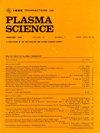回顾螺旋发电机的运行
IF 1.5
4区 物理与天体物理
Q3 PHYSICS, FLUIDS & PLASMAS
引用次数: 0
摘要
螺旋发生器(SG)是上世纪中叶引入的一种脉冲电源,其工作原理是基于传输线中的瞬态过程,即所谓的“矢量反转发生器”(VIG)。SGs因其简单而受到青睐,广泛用于需要数千伏高压脉冲和脉冲持续时间为$10^{-9}$ - $10^{-7}$ $ s的研究和应用中。在本研究中,我们介绍了三种不同尺寸和几何形状的SGs,负载,火花间隙触发开关,以及有无铁氧体的实验结果。输出电压、开关电流、磁场和其他各种可测量的量被监测。研究发现,SG内外的输出电压和磁场几乎与通过一次开关的放电电流同时出现。基于这些观察和输入输出阻抗测量,导出了SG作为变压器的模型,并根据实验中获得的输出电压和开关电流波形进行了测试。该模型与实验结果吻合较好。最后,给出了该模型电路元件的解析表达式,并给出了实现最大电压倍增的SG的设计考虑。本文章由计算机程序翻译,如有差异,请以英文原文为准。
Revisiting Spiral Generator Operation
A spiral generator (SG) is a pulsed power source introduced in the middle of the previous century as a generator whose operation is based on transient processes in transmission strip lines, a so-called “vector inversion generator” (VIG). SGs are favored for their simplicity and are widely used in research and applications that require high-voltage (HV) pulses of several kilovolt and pulse duration of $10^{-9}$ – $10^{-7}$ s. In this study, we present the results of experiments on three different SGs of varying sizes and geometries, loads, spark gap triggering switches, and with or without ferrites. The output voltage, switch current, magnetic field, and other various measurable quantities are monitored. It is found that the output voltage and magnetic field inside and outside the SG appear virtually simultaneously with the discharge current through the primary switch. Based on these observations and on input and output impedance measurements, a model of the SG as a transformer is derived and tested against output voltage and switch current waveforms obtained in experiments. The proposed model shows good agreement with the experimental results. Finally, analytic expressions for the circuit elements of the model are devised, and design considerations of the SG for maximal voltage multiplication are shown.
求助全文
通过发布文献求助,成功后即可免费获取论文全文。
去求助
来源期刊

IEEE Transactions on Plasma Science
物理-物理:流体与等离子体
CiteScore
3.00
自引率
20.00%
发文量
538
审稿时长
3.8 months
期刊介绍:
The scope covers all aspects of the theory and application of plasma science. It includes the following areas: magnetohydrodynamics; thermionics and plasma diodes; basic plasma phenomena; gaseous electronics; microwave/plasma interaction; electron, ion, and plasma sources; space plasmas; intense electron and ion beams; laser-plasma interactions; plasma diagnostics; plasma chemistry and processing; solid-state plasmas; plasma heating; plasma for controlled fusion research; high energy density plasmas; industrial/commercial applications of plasma physics; plasma waves and instabilities; and high power microwave and submillimeter wave generation.
 求助内容:
求助内容: 应助结果提醒方式:
应助结果提醒方式:


